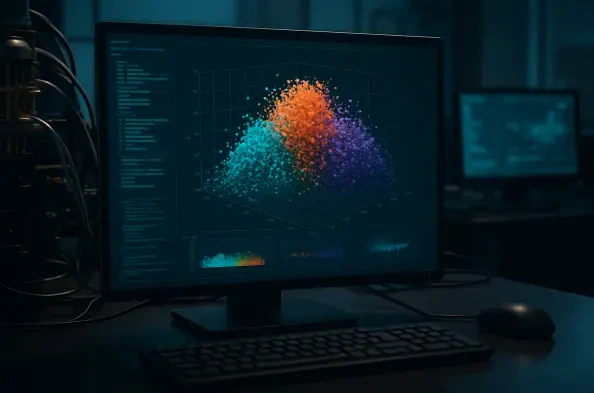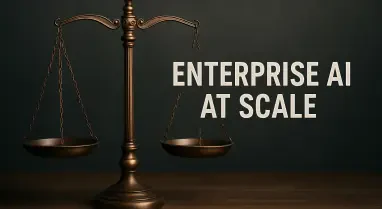In a world increasingly driven by data, where industries grapple with the sheer volume and complexity of information, a transformative solution has emerged to redefine the landscape of artificial intelligence and data processing. WiMi Hologram Cloud Inc. (NASDAWIMI) has captured the attention of the tech community with a groundbreaking announcement on October 1, 2025, introducing a quantum-assisted unsupervised data clustering technology. This innovative approach integrates quantum computing with artificial neural networks, specifically through the Self-Organizing Map (SOM) algorithm, to address the persistent challenges of handling massive, high-dimensional datasets. Such a development is not merely a technical milestone but a potential game-changer for how critical insights are derived from complex information across various sectors. The promise of faster, more efficient data analysis sparks curiosity about how this fusion of quantum and classical methods might reshape the future of computing and decision-making on a global scale.
This leap forward highlights a critical shift in the tech industry, moving quantum computing from theoretical exploration into practical, impactful applications. By tackling long-standing issues such as slow processing speeds and high resource demands inherent in traditional clustering algorithms, WiMi positions itself at the forefront of a computational revolution. The implications ripple beyond the confines of a lab, offering a glimpse into a future where data-driven decisions in fields like finance, bioinformatics, and transportation could reach unprecedented levels of precision and speed. This announcement also underscores a broader trend of merging quantum capabilities with AI, setting the stage for a deeper exploration of its technical, market, and societal impacts.
Exploring the Core Technology
Diving into Quantum-Classical Synergy
At the heart of WiMi’s latest innovation lies a sophisticated hybrid architecture that seamlessly blends quantum and classical computing to enhance unsupervised data clustering. This system leverages the SOM algorithm, a neural network technique known for organizing complex data into meaningful patterns. Quantum computing takes on the heavy computational load, particularly in identifying the “Best Matching Unit” (BMU), a critical step in clustering where data points are matched to neurons. By encoding data into quantum states, the technology harnesses parallel processing to dramatically accelerate this search process. Techniques such as Grover’s search algorithm further optimize performance by reducing the number of queries needed to compute distances between data points and neurons, offering a stark contrast to the slower, resource-intensive methods of traditional systems.
Beyond the initial quantum-driven search, the system employs classical computing for fine-tuning, ensuring that neuron weights are adjusted with precision for effective self-organization of the network. This dual approach mitigates the limitations of conventional clustering methods, which often struggle with high-dimensional data due to escalating computational complexity. The ability to split tasks between quantum and classical components not only boosts efficiency but also showcases a pragmatic solution to current quantum hardware constraints. Such a design marks a significant step toward making quantum-enhanced AI tools viable for real-world challenges, paving the way for broader adoption across data-intensive environments.
Flexibility for Varied Analytical Demands
One of the standout features of this technology is its adaptability to diverse data analysis needs, setting it apart from rigid, one-size-fits-all traditional approaches. The system dynamically adjusts the depth of quantum searches based on the complexity of the task at hand, striking an optimal balance between speed and accuracy. For simpler datasets, it may limit quantum involvement to conserve resources, while for intricate, high-dimensional data, it ramps up quantum processing to ensure thorough exploration of patterns. This flexibility makes the solution a versatile tool, capable of addressing a wide spectrum of challenges, from financial modeling to biological data interpretation, without sacrificing performance.
Moreover, this adaptability extends to how the technology integrates with existing infrastructures, allowing businesses to incorporate quantum-assisted clustering without overhauling their current systems. The seamless interplay between quantum acceleration and classical refinement ensures that results remain reliable, even as datasets grow in scale and intricacy. By prioritizing efficiency tailored to specific demands, WiMi’s innovation offers a forward-thinking approach that can evolve alongside advancements in both quantum hardware and data science methodologies. This capacity to adapt underscores the potential for sustained relevance in an ever-changing technological landscape.
Market Dynamics and Industry Shifts
Investor Optimism and Strategic Positioning
The unveiling of WiMi’s quantum-assisted AI technology has generated significant buzz in financial markets, reinforcing the company’s reputation as a trailblazer in quantum AI integration. Past indicators of investor confidence, such as a 1.48% premarket stock increase on September 19, 2025, following related quantum developments, and a remarkable 926% surge in net income for the first half of the year, suggest a strong positive outlook. Industry experts have hailed this announcement as a defining moment, emphasizing its potential to set new benchmarks in data processing efficiency. WiMi’s strategic focus on quantum innovation positions it as a leader in a niche yet rapidly growing field, likely attracting further investment and interest from stakeholders eager to capitalize on next-generation computing solutions.
This positive market sentiment also reflects broader recognition of the technology’s capacity to address critical pain points in data analytics, enhancing WiMi’s appeal to industries reliant on rapid, accurate insights. As a frontrunner, the company stands to carve out a significant share of the market, particularly in sectors where data clustering is pivotal to operational success. The momentum from this announcement could catalyze partnerships or acquisitions, further solidifying WiMi’s standing against competitors. Such developments highlight how technological leadership can translate into tangible financial and strategic advantages in a competitive tech ecosystem.
Competitive Pressures and Sector-Wide Effects
WiMi’s breakthrough sends ripples through the AI and cloud computing sectors, challenging established players to accelerate their own quantum research and development efforts. Tech giants such as Amazon Web Services, Microsoft Azure, and Google Cloud now face pressure to innovate or integrate similar quantum-assisted technologies to maintain their dominance in data processing services. For smaller AI startups, the bar has been raised, necessitating the adoption of quantum-inspired solutions or risking obsolescence in a market increasingly defined by cutting-edge performance standards. This shift could spur a wave of innovation as companies vie to match or exceed the efficiency benchmarks set by WiMi’s hybrid approach.
Additionally, the impact extends to hardware providers, with a likely surge in demand for specialized quantum processing units and hybrid architectures to support these advanced systems. This trend signals a broader industry pivot toward integrating quantum computing into mainstream applications, pushing beyond experimental phases into commercial viability. Collaborative opportunities may arise, as larger providers might seek to license or incorporate WiMi’s technology into their platforms, while hardware manufacturers align their offerings with emerging needs. Such dynamics illustrate how a single innovation can reshape competitive landscapes, driving both rivalry and potential alliances across the tech sector.
Wider Implications and Emerging Trends
Revolutionizing Sector-Specific Applications
The potential of WiMi’s quantum-assisted clustering technology to transform industries is immense, particularly in areas where precise data analysis is a cornerstone of progress. In finance, enhanced clustering could lead to more accurate risk assessments and fraud detection models by identifying subtle patterns in vast transaction datasets. Bioinformatics stands to benefit through faster analysis of genetic data, accelerating drug discovery and personalized medicine initiatives. Similarly, intelligent transportation systems could optimize traffic flow and logistics with real-time data insights, reducing inefficiencies on a massive scale. These applications underscore how quantum-driven precision can address real-world challenges with unparalleled effectiveness.
Furthermore, the technology opens doors to entirely new services and products previously deemed unfeasible due to computational limitations. For instance, real-time anomaly detection in cybersecurity could become more robust, safeguarding critical infrastructures against evolving threats. Supply chain management might see dramatic improvements through predictive clustering, enabling proactive adjustments to disruptions. By empowering industries to extract deeper value from their data, WiMi’s innovation acts as a catalyst for operational advancements and competitive differentiation, highlighting the far-reaching potential of quantum AI integration in practical settings.
Ethical and Regulatory Horizons
As quantum AI tools like WiMi’s gain prominence, they bring to the forefront pressing concerns about data privacy, security, and ethical deployment. The ability to process vast datasets with unprecedented speed raises questions about how sensitive information is handled and protected against misuse. Potential algorithmic biases embedded in clustering outcomes could also perpetuate unfair practices if not addressed, necessitating transparent methodologies. Governments and international regulatory bodies may find themselves compelled to establish guidelines ensuring that such powerful technologies are used responsibly across sectors.
Historical patterns suggest that significant technological advancements often prompt shifts in policy to balance innovation with societal well-being. The emergence of quantum-assisted AI could accelerate the need for updated data protection laws and ethical standards, especially as applications expand into critical areas like healthcare and finance. Industry stakeholders might need to collaborate with policymakers to shape frameworks that foster trust and accountability. Addressing these challenges early will be crucial to prevent backlash and ensure that the benefits of quantum AI are realized without compromising fundamental rights or security.
Future Pathways and Potential Hurdles
Near-Term Strategies for Market Penetration
In the immediate aftermath of this announcement, WiMi’s focus will likely center on demonstrating the scalability and practical value of its quantum-assisted clustering technology through targeted pilot projects. Engaging with enterprises in data-intensive sectors such as finance and pharmaceuticals could provide compelling case studies, showcasing tangible benefits like reduced processing times and enhanced analytical accuracy. Strategic partnerships with industry leaders may also play a key role, enabling WiMi to integrate its solution into existing workflows and gain credibility among potential adopters. These initial steps are vital for building momentum and establishing a foothold in competitive markets.
Offering this technology as a cloud-based service presents another promising avenue for rapid market penetration. Such a model would appeal to businesses grappling with large datasets but lacking the infrastructure or expertise to implement quantum solutions in-house. By providing accessible, scalable tools, WiMi could attract a diverse client base, from startups to multinational corporations, seeking a competitive edge through advanced data insights. This approach not only democratizes access to cutting-edge technology but also positions WiMi as a versatile provider capable of meeting varied customer needs in the short term, setting the stage for broader adoption.
Expanding Horizons in AI Domains
Looking further ahead, WiMi’s commitment to quantum research suggests ambitions to extend the application of quantum algorithms beyond clustering into other AI domains like predictive analytics, natural language processing, and computer vision. Success in these areas could establish the company as a central figure in quantum AI infrastructure, offering specialized software or platforms that redefine computational capabilities. The potential to create synergies with existing holographic augmented reality offerings further enhances the scope of innovation, merging front-end user experiences with back-end data intelligence for holistic solutions.
Achieving this long-term vision will require sustained investment in research and development to refine algorithms and adapt them to diverse challenges. Collaboration with academic institutions and tech consortiums could accelerate progress, fostering an ecosystem where quantum AI becomes a cornerstone of digital transformation. While the roadmap is ambitious, it reflects a strategic intent to lead in a future where quantum computing underpins a wide array of technological advancements. Navigating this path will demand not only technical prowess but also a keen understanding of evolving market demands and user expectations.
Overcoming Hardware and Competitive Obstacles
Significant challenges persist in the realm of quantum hardware, which remains in a nascent stage with issues like high error rates and limited qubit stability constraining full potential. WiMi must prioritize advancements in error correction and hardware scalability to ensure that its hybrid systems deliver consistent performance at scale. Partnerships with quantum hardware developers could be instrumental in addressing these technical barriers, enabling the transition from experimental setups to robust, commercial-grade solutions. Without such progress, the transformative promise of quantum-assisted AI risks being delayed or diminished.
Competition poses another formidable hurdle, as tech giants and agile startups alike intensify their focus on quantum computing. Larger players with vast resources could replicate or surpass WiMi’s innovations, while smaller firms might carve out niche advantages through specialized applications. Staying ahead will require continuous innovation, strategic differentiation, and agility in responding to market shifts. WiMi’s ability to maintain a competitive edge hinges on balancing technological leadership with operational efficiency, ensuring that it remains a preferred partner for businesses exploring quantum solutions amidst a crowded and dynamic field.
Addressing Regulatory and Educational Gaps
The evolving regulatory landscape surrounding quantum data processing presents an additional layer of complexity, as policies struggle to keep pace with technological advancements. Ensuring compliance with emerging data privacy and security standards will be critical, particularly as applications touch sensitive sectors. Proactive engagement with regulatory bodies to shape balanced frameworks could mitigate risks of restrictive policies that hinder innovation. Transparent communication about how quantum AI handles data will also be essential to build trust among users and stakeholders concerned about ethical implications.
Equally important is the challenge of market education, as many businesses lack the quantum literacy needed to fully grasp the benefits and intricacies of such technologies. WiMi faces the task of demystifying quantum-assisted solutions through accessible resources, training programs, and case studies that highlight practical value. Bridging this knowledge gap will be key to driving adoption, as enterprises must feel confident in integrating these tools into their operations. Overcoming these educational and regulatory barriers will not only facilitate smoother market entry but also ensure that the technology’s transformative potential is realized responsibly and sustainably.






